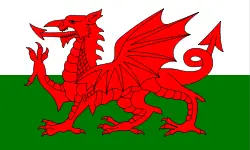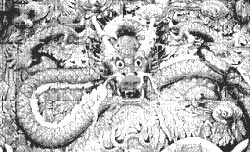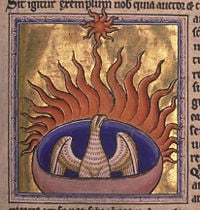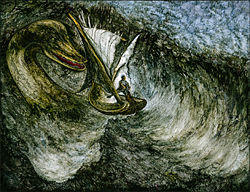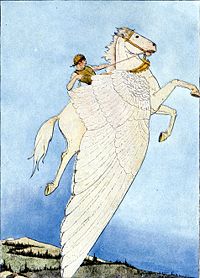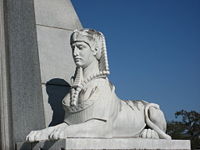Difference between revisions of "Mythical creature" - New World Encyclopedia
| Line 47: | Line 47: | ||
*[[Mokele-mbembe]] of the [[Congo River]] in [[Congo]] | *[[Mokele-mbembe]] of the [[Congo River]] in [[Congo]] | ||
| + | [[Image:Behemoth3.jpg|thumb|left|180px|''Behemoth and Leviathan'', an engraving by [[William Blake]]]] | ||
===Monstrous creatures=== | ===Monstrous creatures=== | ||
| − | |||
;[[Behemoth]]: Behemoth is the primal unconquerable monster of the land, as [[Leviathan]] is the primal monster of the waters of the sea and [[Ziz]] the primordial monster of the sky. There is a legend that the Leviathan and the Behemoth shall hold a battle at the end of the world. The two will finally kill each other, and the surviving men will feast on their meat. | ;[[Behemoth]]: Behemoth is the primal unconquerable monster of the land, as [[Leviathan]] is the primal monster of the waters of the sea and [[Ziz]] the primordial monster of the sky. There is a legend that the Leviathan and the Behemoth shall hold a battle at the end of the world. The two will finally kill each other, and the surviving men will feast on their meat. | ||
;[[Leviathan]]: Leviathan is a [[Bible|Biblical]] [[sea monster]], referred to in sections of the [[Old Testament]]. It is regarded as the monster of the waters, while the [[Behemoth]] and the [[Ziz]] are regarded as monsters of the earth and the air, respectively. | ;[[Leviathan]]: Leviathan is a [[Bible|Biblical]] [[sea monster]], referred to in sections of the [[Old Testament]]. It is regarded as the monster of the waters, while the [[Behemoth]] and the [[Ziz]] are regarded as monsters of the earth and the air, respectively. | ||
| − | ===Chimeras=== | + | ===Chimeras and hybrids=== |
| + | In [[Greek mythology]], the [[Chimera (mythology)|Chimera]] is a monstrous creature that was composed of several different animals. Other hybrids exist as combinations of human beings with animals and/or birds, as well as a variety of humanoid creatures. | ||
====Animal==== | ====Animal==== | ||
| − | + | ||
| − | + | ;[[Griffin]]: The griffin has the body of a [[lion]] and the head and wings of an [[eagle]]. Seen as guardians of secretly buried wealth, the griffin evolved from a ferocious animal of antiquity to become a [[symbol]] of strength and valor. | |
| − | + | ;[[Minotaur]]: In [[Greek mythology]], the Minotaur was part man and part [[cattle|bull]]. It was kept by [[King Minos]] of [[Crete]] in the center of a "labyrinth," an elaborate [[maze]]-like construction designed by the architect [[Daedalus]] specifically to hold the Minotaur. According to [[legend]], the Minotaur required human sacrifices on a regular basis. [[Theseus]] volunteered to be sacrificed, and with the help of Daedalus, was able to slay the Minotaur and escape the maze. | |
| − | + | [[Image:The-Winged-Horse.jpg|thumb|200px|right|Pegasus and Bellerophon, from Hamilton Wright Mabie, ed.,''Myths Every Child Should Know'' (1914)]] | |
| − | + | ;[[Pegasus]]: Pegasus is the famous winged [[horse]] of [[Greek mythology]]. Riding on Pegasus [[Bellerophon]] was able to defeat the [[chimera (mythology)|chimera]]. However, Bellerophon tried to fly to [[Mount Olympus]], the realm of the Gods, on Pegasus' back. Pegasus threw Bellerophon from his back for such blasphemous behavior, and was awarded his own place in Mount Olympus. | |
| + | ;[[Unicorn]]: The unicorn, usually depicted with the body of a [[horse]], but with a single—usually spiral—horn growing out of its forehead, is one of the most revered mythical beasts of all time. Appearing in numerous [[culture]]s, the unicorn has come to be a symbol of purity and [[beauty]], and is one of the few mythical creatures not associated with violence, danger, and fear. | ||
====Part-human==== | ====Part-human==== | ||
| − | + | ;[[Centaur]]: In [[Greek mythology]], the centaurs are a race of mythical creatures that are half [[human]] and half [[horse]]. IThey are depicted as the head and torso of a man with his waist joined to the horse's withers, where the horse's neck would be. | |
| − | + | ;[[Gorgon]]: In [[Greek mythology]], the Gorgons were three vicious female [[mythical creature]]s that lived on an [[island]] and possessed the ability to turn a person to [[stone]] by looking at them. They possessed both beautiful and hideous traits, the most famous being their head of coiled [[snake]]s instead of [[hair]]. Of the three, [[Medusa]] is perhaps the most famous of the Gorgons, being the only one of the three who was [[mortality|mortal]]. She, like many such creatures, met her doom at the hands of a [[hero]] aided by the [[polytheism|god]]s. | |
| − | + | ;[[Harpy]]: Harpies in [[Greek mythology]] were winged-beasts that were sent down by [[Zeus]] to punish, most famously the [[prophet]] [[Phineus]]. Like many other second-tier Greek creatures, the Harpies were more prominent in [[art]] works than in mythological literature, and while they may occasionally be used in popular culture today, they are most widely remembered for their part in the [[legend]]ary adventures of [[Jason and the Argonauts]]. | |
| − | + | ;[[Manticore]]: The manticore of Central [[Asia]] is a kind of [[chimera (mythology)|chimera]], that is sometimes said to be related to the [[Sphinx]]. It was often feared as being violent and feral, but it was not until the manticore was incorporated into [[Europe]]an [[mythology]] during the [[Middle Ages]] that it came to be regarded as an [[omen]] of [[evil]]. | |
| − | + | ;[[Mermaid]]: A mermaid is an aquatic creature with the head and torso of human female and a [[fish]]-like tail. The male version of a mermaid is known as a merman, and the gender-neutral plural is merfolk or merpeople. Merfolk appear in a plethora of cultures worldwide—[[legend]]s often tell of mermaids singing to sailors, enchanting them, and luring them to their death. | |
| − | + | ;[[Siren]]: In [[Greek mythology]] the Sirens were creatures who lived on a remote island surrounded by rocky cliffs. The Sirens lured passing sailors by their [[song|singing]], which would enchant any sailor listening to the point that he would lose all will-power, and crash his ship upon the Sirens' rocky shore and cliffs, killing all the men aboard. | |
| − | + | [[Image:MetCemBrunswigSphynx.jpg|thumb|200 px|Marble '''sphynx''' on tomb in Metairie Cemetery, New Orleans]] | |
| − | + | ;[[Sphinx]]: The sphinx has had a long history of secrecy and intrigue, being viewed by many [[culture]]s as guardians of knowledge and as speaking in riddles. The sphinx varies in physical features, but is almost always a composite of two or more animals, and some versions are part-human part-animal. In [[ancient Egypt]] there are three distinct types of sphinx: The '''Androsphinx''', with the body of a [[lion]] and head of person; a '''Criosphinx''', body of a lion with the head of [[sheep|ram]]; and '''Hierocosphinx''', that had a body of a lion with a head of a [[falcon]] or [[hawk]]. In [[Greek mythology]] there is less variation: a winged lion with a woman's head, or a woman with the paws, claws, and breasts of a lion, a [[serpent]]'s tail and [[eagle]] wings. | |
| + | ;[[Tengu]]: Tengu ("heavenly dogs") are a class of supernatural creatures found in [[Japanese folklore]], [[Japanese art|art]], [[Japanese theater|theater]], [[Japanese literature|literature]] and religious mythology. These Japanese spirits were originally thought to take the forms of birds of prey, such that they are traditionally depicted with both human and avian characteristics. In the earliest sources, ''tengu'' were actually pictured with beaks, but, in later depictions, these features have often been anthropomorphized into unnaturally long noses. In the modern imagination (and especially in artistic works), this single characteristic (the expansive proboscis) is the most definitive aspect of the ''tengu''. These crafty (oftentimes dangerous) bird-men were long held to be disruptive [[demon]]s and harbingers of war (much like their Chinese prototypes). In their malevolent and disruptive behaviors, the ''tengu'' shared similarities with European [[goblin]]s. Over time, this overtly negative evaluation was softened somewhat, as the Buddhists came to acknowledge the popular conception of these spirits as morally-ambivalent protectors of the mountains and forests, who were as likely to bring windfalls as calamities to humans intruding upon their domains.In this respect, they share certain similarities with the medieval European understanding of [[fairy|fairies]] | ||
===Humanoid creatures=== | ===Humanoid creatures=== | ||
| − | + | ;[[Banshee]]: | |
| − | + | ;[[Dwarf]]: | |
| − | + | ;[[Elf]]: | |
| − | + | ;[[Fairy]]: | |
| − | + | ;[[Gnome]]: | |
| − | + | ;[[Goblin]]: | |
| − | + | ;[[Leprechaun]]: | |
| − | + | ;[[Nymph]]: | |
| − | + | ;[[Ogre]]: | |
| − | + | ;[[Orc]]: | |
| − | + | ;[[Pixie]]: | |
| − | + | ;[[Sasquatch]]: | |
| − | + | ;[[Troll]]: | |
| − | + | ;[[Vampire]]: | |
| − | + | ;[[Werewolf]]: | |
| − | + | ;[[Wendigo]]: | |
| − | + | ;[[Yeti]]: | |
===Other=== | ===Other=== | ||
| − | + | ;[[Kelpie]]: The kelpie is a supernatural shape-shifting water [[horse]] from [[Celtic folklore]]. | |
==References== | ==References== | ||
Revision as of 18:30, 12 November 2007
A mystical, mythical, or legendary creature is a creature from mythology or folklore (often known as "fabulous creatures" in historical literature). Some — such as the dragon or the griffin — have their origin in traditional mythology and have at one time been believed to be real creatures. Others were based on real creatures, originating in garbled accounts of travelers' tales; such as the Vegetable Lamb of Tartary, which supposedly grew tethered to the earth (and was actually a type of fern). The traditional unicorn may have come from garbled stories about the rhinoceros and/or narwhal. Examples of the legendary creatures can be found in medieval bestiaries.
Conversely, some creatures downplayed as just storytelling, have been rediscovered and found to be real in recent times, such as the giant squid.
Often mythical creatures are chimeras, a combination of two or more animals. Some of these are combinations of a human being and one or more other creatures. For example, a centaur is a combination of a man and horse, a minotaur of a man andbull. It should be noted that these were not always intended to be understood as literal juxtapositions of parts from disparate species. Lacking a common morphological vocabulary, classical and medieval scholars and travelers would attempt to describe unusual animals by comparing them point-for-point with familiar: the giraffe, for example, was called cameleopard, and thought of as a creature half-camel, and half-leopard.
Many legendary creatures appear prominently in fantasy fiction. These creatures are often claimed to have supernatural powers or knowledge or to guard some object of great value, which becomes critical to the plot of the story in which it is found.
Many legendary creatures have been incorporated into heraldry and architectural decoration. Legendary creatures have also been accepted into many facets of popular culture most notably in fantasy role playing games such as Dungeons & Dragons or Everquest, video games, Hollywood movies and power metal bands (such as DragonForce)).
Examples
Birds and serpents
- Basilisk
- Most often depicted as a reptile, the basilisk is reputed to be king of serpents. One of the most feared of all mythological beasts, a basilisk is said to have the power to cause death with a single glance. In this aspect it bears similarity to the Gorgons of Greek mythology.
- Chinese dragon
- Also appearing in other East Asian cultures, it is also sometimes called the Oriental (or Eastern) dragon. The Chinese dragon is easily recognizable for its long serpentine body that is generally wingless, and its anthropomorphic face, complete with beard. The oriental dragon is generally considered a supernatural or spiritual symbol of heavenly power.
- Dragon
- Typically depicted as a large and powerful Serpent or other reptile it has magical or spiritual qualities, the most famous being the ability to breathe fire from their mouths. More often than not dragons were considered malevolent, associated with evil supernatural forces and the natural enemy of humanity.
- Feng-huang
- Sometimes called the Chinese Phoenix, the feng-huang is a symbol of summer and spiritual balance, and along with the dragon, qilin and tortoise, is one of the most high revered creatures in Chinese tradition. Its appearance is said to indicate some great event, or to bear testimony to the greatness of a ruler. It is often viewed as the sacred union of male and female, Feng being male and Huang female, but also the Feng-Huang can be regarded as a female entity in relation with the male dragon.
- Phoenix
- Characterized as a bird with brightly colored plumage, after a long life the phoenix dies in a fire of its own making only to rise again from the ashes.
- Ziz
- A giant bird in Jewish mythology, the ziz is the counterpart in the air of the Behemoth (giant creature of land) and Leviathan (giant creature of water). The Ziz is said to be large enough to be able to block out the sun with its wingspan.
Lake monsters
Lake monster or loch monster is the name given to large unknown animals which have purportedly been sighted in, and/or are believed to dwell in freshwaters, although their existence has never been confirmed scientifically. They are generally believed not to exist by conventional zoology and allied sciences, and are principally the subject of investigations by followers of cryptozoology. Sightings are often similar to some sea monsters.
Of these, Nessie of Loch Ness is almost certainly the most famous, and is promoted heavily in the area's tourist industry.
Other well known lake monsters include:
- Champ of Lake Champlain in North America
- Bessie of Lake Erie in the United States
- Chessie of Chesapeake Bay in the United States
- Ogopogo of Lake Okanagan in Canada
- Nahuelito of Nahuel Huapi Lake in Argentina
- Lake Tianchi Monster of Heaven Lake (known as Tianchi (天池) in Chinese and Chonji (천지) in Korean) on the border of China and North Korea
- Isshii of Lake Ikeda in Japan
- Brosno dragon of Lake Brosno in Russia
- Mokele-mbembe of the Congo River in Congo
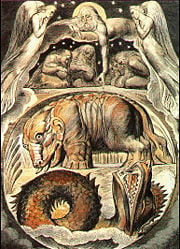
Monstrous creatures
- Behemoth
- Behemoth is the primal unconquerable monster of the land, as Leviathan is the primal monster of the waters of the sea and Ziz the primordial monster of the sky. There is a legend that the Leviathan and the Behemoth shall hold a battle at the end of the world. The two will finally kill each other, and the surviving men will feast on their meat.
- Leviathan
- Leviathan is a Biblical sea monster, referred to in sections of the Old Testament. It is regarded as the monster of the waters, while the Behemoth and the Ziz are regarded as monsters of the earth and the air, respectively.
Chimeras and hybrids
In Greek mythology, the Chimera is a monstrous creature that was composed of several different animals. Other hybrids exist as combinations of human beings with animals and/or birds, as well as a variety of humanoid creatures.
Animal
- Griffin
- The griffin has the body of a lion and the head and wings of an eagle. Seen as guardians of secretly buried wealth, the griffin evolved from a ferocious animal of antiquity to become a symbol of strength and valor.
- Minotaur
- In Greek mythology, the Minotaur was part man and part bull. It was kept by King Minos of Crete in the center of a "labyrinth," an elaborate maze-like construction designed by the architect Daedalus specifically to hold the Minotaur. According to legend, the Minotaur required human sacrifices on a regular basis. Theseus volunteered to be sacrificed, and with the help of Daedalus, was able to slay the Minotaur and escape the maze.
- Pegasus
- Pegasus is the famous winged horse of Greek mythology. Riding on Pegasus Bellerophon was able to defeat the chimera. However, Bellerophon tried to fly to Mount Olympus, the realm of the Gods, on Pegasus' back. Pegasus threw Bellerophon from his back for such blasphemous behavior, and was awarded his own place in Mount Olympus.
- Unicorn
- The unicorn, usually depicted with the body of a horse, but with a single—usually spiral—horn growing out of its forehead, is one of the most revered mythical beasts of all time. Appearing in numerous cultures, the unicorn has come to be a symbol of purity and beauty, and is one of the few mythical creatures not associated with violence, danger, and fear.
Part-human
- Centaur
- In Greek mythology, the centaurs are a race of mythical creatures that are half human and half horse. IThey are depicted as the head and torso of a man with his waist joined to the horse's withers, where the horse's neck would be.
- Gorgon
- In Greek mythology, the Gorgons were three vicious female mythical creatures that lived on an island and possessed the ability to turn a person to stone by looking at them. They possessed both beautiful and hideous traits, the most famous being their head of coiled snakes instead of hair. Of the three, Medusa is perhaps the most famous of the Gorgons, being the only one of the three who was mortal. She, like many such creatures, met her doom at the hands of a hero aided by the gods.
- Harpy
- Harpies in Greek mythology were winged-beasts that were sent down by Zeus to punish, most famously the prophet Phineus. Like many other second-tier Greek creatures, the Harpies were more prominent in art works than in mythological literature, and while they may occasionally be used in popular culture today, they are most widely remembered for their part in the legendary adventures of Jason and the Argonauts.
- Manticore
- The manticore of Central Asia is a kind of chimera, that is sometimes said to be related to the Sphinx. It was often feared as being violent and feral, but it was not until the manticore was incorporated into European mythology during the Middle Ages that it came to be regarded as an omen of evil.
- Mermaid
- A mermaid is an aquatic creature with the head and torso of human female and a fish-like tail. The male version of a mermaid is known as a merman, and the gender-neutral plural is merfolk or merpeople. Merfolk appear in a plethora of cultures worldwide—legends often tell of mermaids singing to sailors, enchanting them, and luring them to their death.
- Siren
- In Greek mythology the Sirens were creatures who lived on a remote island surrounded by rocky cliffs. The Sirens lured passing sailors by their singing, which would enchant any sailor listening to the point that he would lose all will-power, and crash his ship upon the Sirens' rocky shore and cliffs, killing all the men aboard.
- Sphinx
- The sphinx has had a long history of secrecy and intrigue, being viewed by many cultures as guardians of knowledge and as speaking in riddles. The sphinx varies in physical features, but is almost always a composite of two or more animals, and some versions are part-human part-animal. In ancient Egypt there are three distinct types of sphinx: The Androsphinx, with the body of a lion and head of person; a Criosphinx, body of a lion with the head of ram; and Hierocosphinx, that had a body of a lion with a head of a falcon or hawk. In Greek mythology there is less variation: a winged lion with a woman's head, or a woman with the paws, claws, and breasts of a lion, a serpent's tail and eagle wings.
- Tengu
- Tengu ("heavenly dogs") are a class of supernatural creatures found in Japanese folklore, art, theater, literature and religious mythology. These Japanese spirits were originally thought to take the forms of birds of prey, such that they are traditionally depicted with both human and avian characteristics. In the earliest sources, tengu were actually pictured with beaks, but, in later depictions, these features have often been anthropomorphized into unnaturally long noses. In the modern imagination (and especially in artistic works), this single characteristic (the expansive proboscis) is the most definitive aspect of the tengu. These crafty (oftentimes dangerous) bird-men were long held to be disruptive demons and harbingers of war (much like their Chinese prototypes). In their malevolent and disruptive behaviors, the tengu shared similarities with European goblins. Over time, this overtly negative evaluation was softened somewhat, as the Buddhists came to acknowledge the popular conception of these spirits as morally-ambivalent protectors of the mountains and forests, who were as likely to bring windfalls as calamities to humans intruding upon their domains.In this respect, they share certain similarities with the medieval European understanding of fairies
Humanoid creatures
- Banshee
- Dwarf
- Elf
- Fairy
- Gnome
- Goblin
- Leprechaun
- Nymph
- Ogre
- Orc
- Pixie
- Sasquatch
- Troll
- Vampire
- Werewolf
- Wendigo
- Yeti
Other
- Kelpie
- The kelpie is a supernatural shape-shifting water horse from Celtic folklore.
ReferencesISBN links support NWE through referral fees
- Ashman, Malcolm and Joyce Hargreaves. 1997. Fabulous Beasts. Overlook. ISBN 978-0879517793
- Barber, Richard. 2006. Bestiary: Being an English Version of the Bodleian Library, Oxford, MS Bodley 764. Boydell Press. ISBN 978-0851157535
- Borges, Jorge Luis. 2005. The Book of Imaginary Beings. Amazon Remainders. ISBN 0670891800
- Conway, D.J. 2001. Magickal Mystical Creatures: Invite Their Powers Into Your Life. Llewellyn Publications. ISBN 156718149X
- Costello, Peter. 1979. The Magic Zoo: The Natural History of Fabulous Animals. St. Martin's Press. ISBN 0312504217
- Dubois, Pierre, Claudine Sabatier, and Roland Sabatier. 2000. The Great Encyclopedia Of Faeries. Simon & Schuster. ISBN 0684869578
- Eason, Cassandra. 2002. A Complete Guide to Faeries & Magical Beings: Explore the Mystical Realm of the Little People. Boston, MA: Red Wheel/Weiser. ISBN 978-1578632671
- Ellis, Richard. 2006. Monsters of the Sea. The Lyons Press. ISBN 978-1592289677
- Evans-Wentz, W. Y. 2004. The Fairy-Faith in Celtic Countries. New Page Books. ISBN 978-1564147080
- Hassig, Debra. 2000. The Mark of the Beast: The Medieval Bestiary in Art, Life, and Literature. Routledge. ISBN 041592894X
- Keightley, Thomas. 2000. The World Guide to Gnomes, Fairies, Elves & Other Little People. Gramercy. ISBN 0517263130
- Nigg, Joe. 1995. Wonder Beasts: Tales and Lore of the Phoenix, the Griffin, the Unicorn, and the Dragon. Libraries Unlimited. ISBN 156308242X
- Nigg, Joseph. 1999. The Book of Fabulous Beasts: A Treasury of Writings from Ancient Times to the Present. Oxford University Press, USA. ISBN 978-0195095616
- Nigg, Joe. 2001. The Book of Dragons & Other Mythical Beasts. Barron's Educational Series. ISBN 978-0764155109
External links
Credits
New World Encyclopedia writers and editors rewrote and completed the Wikipedia article in accordance with New World Encyclopedia standards. This article abides by terms of the Creative Commons CC-by-sa 3.0 License (CC-by-sa), which may be used and disseminated with proper attribution. Credit is due under the terms of this license that can reference both the New World Encyclopedia contributors and the selfless volunteer contributors of the Wikimedia Foundation. To cite this article click here for a list of acceptable citing formats.The history of earlier contributions by wikipedians is accessible to researchers here:
The history of this article since it was imported to New World Encyclopedia:
Note: Some restrictions may apply to use of individual images which are separately licensed.
